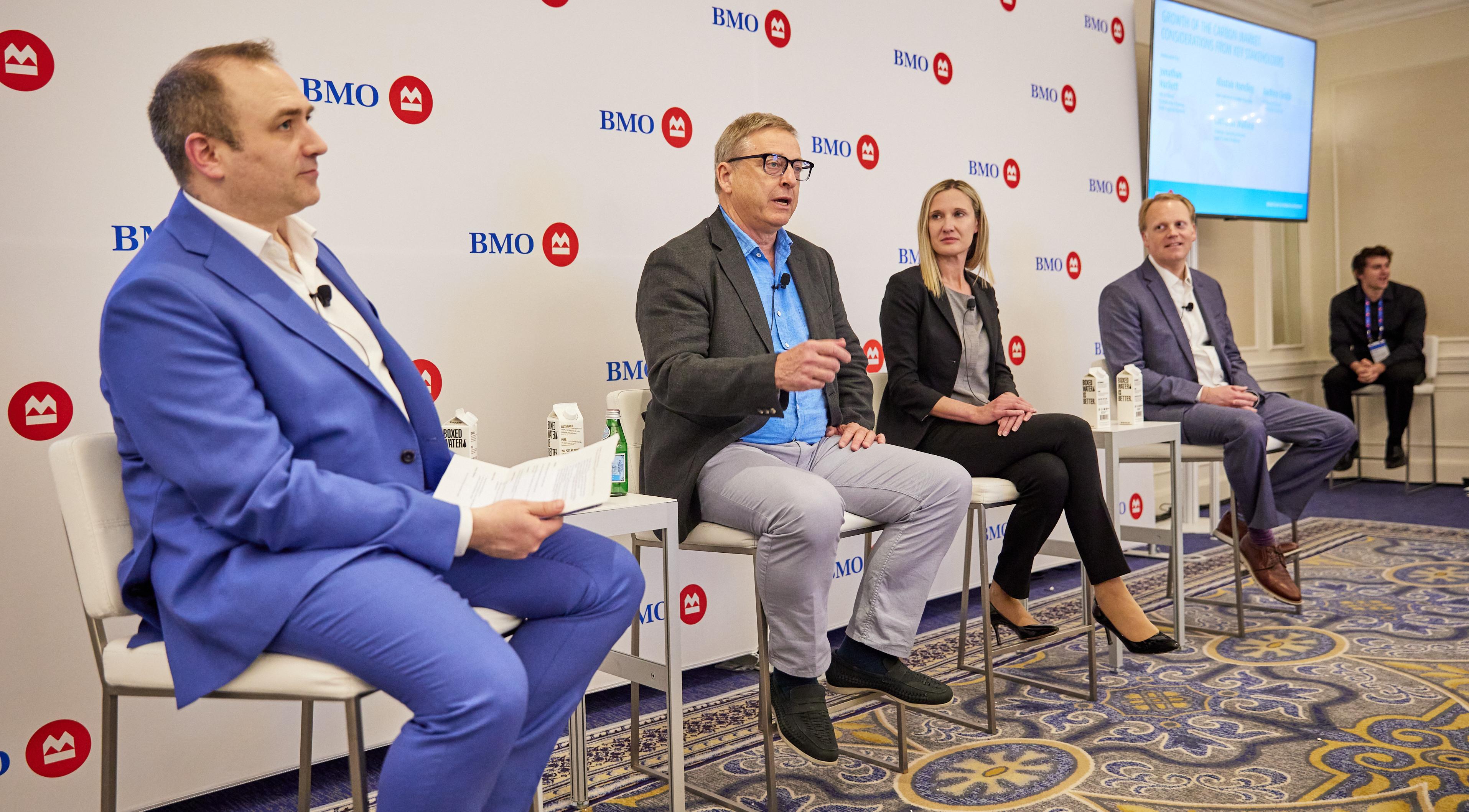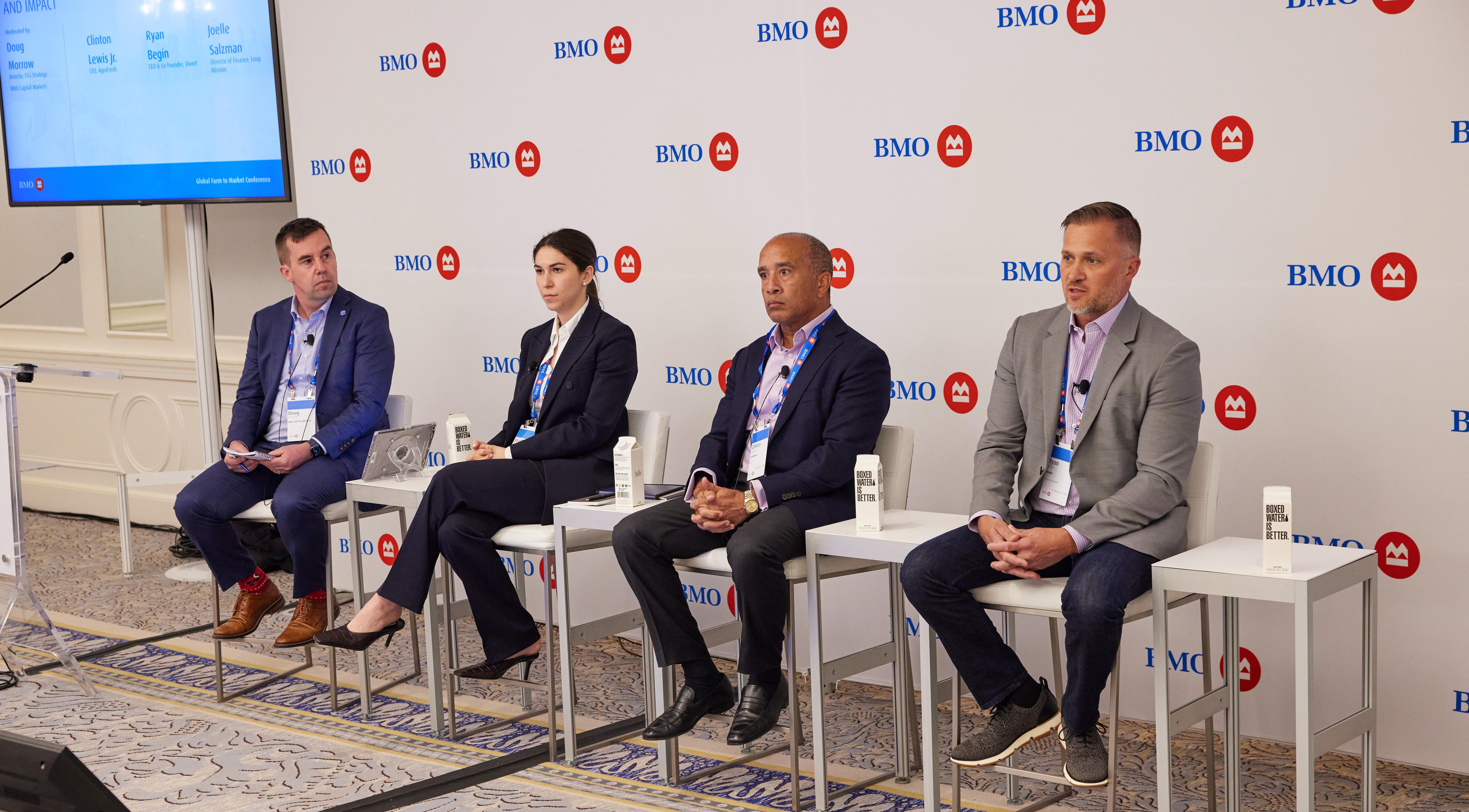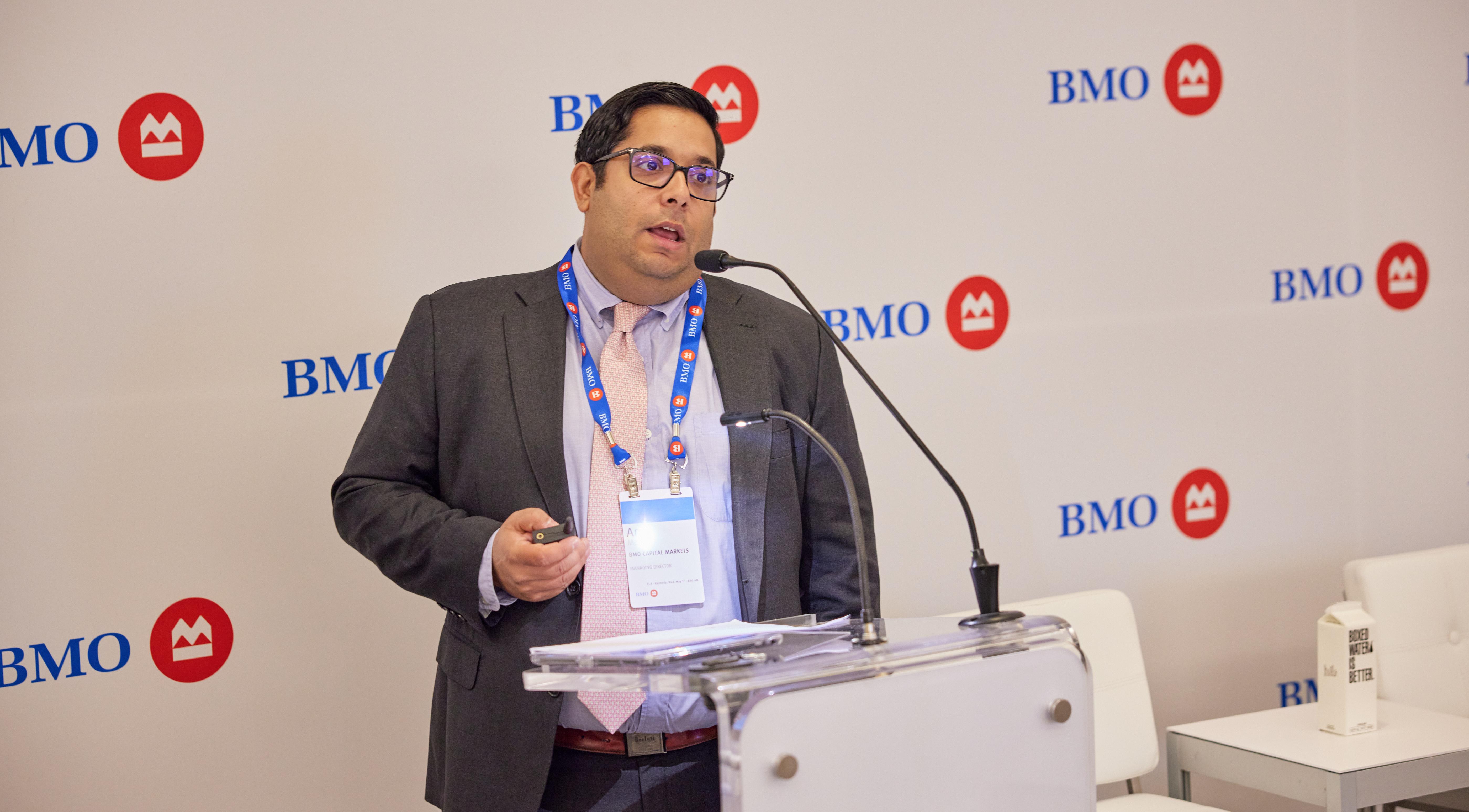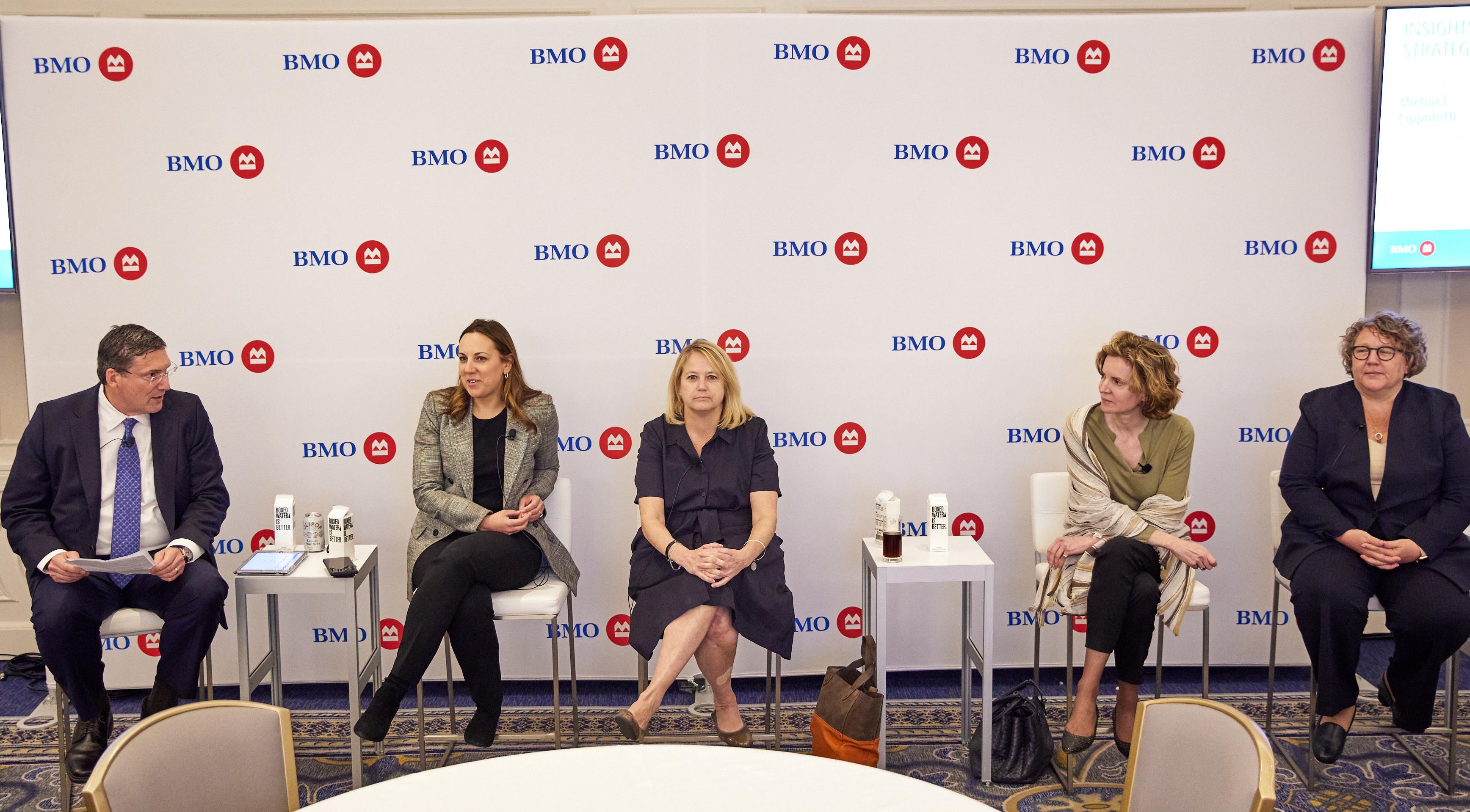
Growth of the Carbon Market: Considerations from Key Stakeholders
-
bookmark
-
print

- Keywords:


With the global compliance carbon market worth more than US$900 billion and the voluntary market forecasted to reach as much as $40 billion by 2030, there’s no shortage of opportunities in the market for trading carbon credits. This was a key takeaway behind the Growth of the Carbon Market – Considerations from Key Stakeholders panel at the BMO Capital Markets 18th annual Farm to Market Conference in New York.
The panel led by Jonathan Hackett, Co-Head, BMO Energy Transition and Head, Sustainable Finance, provided an overview of the carbon markets, including how to make carbon credits more tangible and investible, and featured Alastair Handley, Special Advisor & Founder Emeritus, BMO Radicle; Andrea Gruza, Managing Partner, Bonnefield Financial; and Cameron Wallace, Strategic Operating Director, Land O'Lakes (Truterra).
Assessing the Opportunities
At a basic level, organizations that are making the effort to reduce greenhouse gas emissions or pull greenhouse gases out of the atmosphere in a way that can be verified to meet certain standards can create carbon credits. To create the carbon credit, the activity needs to be developed under an approved methodology, verified by a third party, and uniquely serialized on a registry. Ultimately, that serialized credit will be sold to an emitter that will retire the credit to offset their emissions.
As Handley explained, carbon credits are used as incentives in carbon-producing industries like mining. But he also noted that carbon credits are often “misaligned and misunderstood,” which is why he said companies need to understand the cost, revenue opportunities and risks involved in carbon credit opportunities.
“When we think about carbon credit opportunities back when we started (BMO) Radicle, it was pretty simple,” Handley said. “There was a market, there was a clear price signal, there were clear opportunities to create credits, and real clarity in what we needed to do to generate those credits. Then that expanded [from primary agriculture] into the oil and gas sector, renewable energy, forestry and regenerative agriculture. But within all of those, we saw a clear path to revenue with a high degree of certainty.”
Now, as the market has expanded, many industries find themselves on the leading edge of carbon credit development. With that comes an active debate on the best mechanisms to reduce carbon emissions. “There are certain ways to develop credits today depending on what jurisdiction you're in where it's very clear as to what you need to do to create those credits, and there are very clear price signals,” Handley said. “There are other markets that are emerging where it’s less clear. Like anything else from a business perspective, it’s about understanding the cost, the revenue opportunity, and the risk.”
The Canadian agriculture industry is a case in point, Gruza said. Bonnefield Financial holds about 1.4 billion of Canadian farmland assets, which it invests in on behalf of institutional investors such as pension funds. But Gruza pointed out that agricultural carbon credit trading is difficult because Canada doesn’t currently have a federal program in place.
“Land-based credits are more likely in terms of conservation, biodiversity, or planting trees, as opposed to changing farming practices,” she said. "That's a bit of the problem because a lot of Canadian farmers should be credited for the really good practices they have. It's a combination of the fact that the market is nascent, and the technology is difficult to be able to monitor it. Once we crack those two things, the farming practices are really going to drive credit generation.”
A New Scope
When it comes to how companies are generating and investing in carbon credits within the value chain, Handley said the focus is largely on Scope 3 value chain interventions. That is, how companies are encouraging change within their supply chains.
"If a company is trying to lower its Scope 3 emissions—through the production of a grain product they make, for example—they may go to a farm and say, we want you to undertake this activity and we're going to help you pay for cover crops. They're going to quantify what the associated emission reductions or removal are, and they're going to claim those as a reduction in their supply chain. It's not a credit, per se, but it is an emissions reduction or removal that has a tangible value that's applied through that intervention.”
That’s what Bonnefield Financial advises its clients to focus on. Gruza said that while the institutional investors Bonnefield Financial works with are committed to net zero, they may not know how to approach the market. “We talked to some investors who are thinking about speculating in the carbon markets; they just want to get as much exposure as they can to these credits because they think that the price is going to take off. But I'd say it really is more of the Scope 3 value chain intervention because they need to know their portfolio of investments are not carbon emitters.”
The quality of carbon credits is also a key factor. Truterra works with farmers and dairy producers to help them adopt regenerative farming practices. It also helps food companies address their sustainability commitments. Wallace said generating high-quality credits in agriculture requires two key elements.
“You need some assurance that the practice is going to continue over time because agriculture credits are competing with credits from other engineered solutions, some of which have much longer durability guarantees,” Wallace said.
Jonathan Hackett
Co-Head, BMO Energy Transition and Head, Sustainable Finance
View Full Profile
With the global compliance carbon market worth more than US$900 billion and the voluntary market forecasted to reach as much as $40 billion by 2030, there’s no shortage of opportunities in the market for trading carbon credits. This was a key takeaway behind the Growth of the Carbon Market – Considerations from Key Stakeholders panel at the BMO Capital Markets 18th annual Farm to Market Conference in New York.
The panel led by Jonathan Hackett, Co-Head, BMO Energy Transition and Head, Sustainable Finance, provided an overview of the carbon markets, including how to make carbon credits more tangible and investible, and featured Alastair Handley, Special Advisor & Founder Emeritus, BMO Radicle; Andrea Gruza, Managing Partner, Bonnefield Financial; and Cameron Wallace, Strategic Operating Director, Land O'Lakes (Truterra).
Assessing the Opportunities
At a basic level, organizations that are making the effort to reduce greenhouse gas emissions or pull greenhouse gases out of the atmosphere in a way that can be verified to meet certain standards can create carbon credits. To create the carbon credit, the activity needs to be developed under an approved methodology, verified by a third party, and uniquely serialized on a registry. Ultimately, that serialized credit will be sold to an emitter that will retire the credit to offset their emissions.
As Handley explained, carbon credits are used as incentives in carbon-producing industries like mining. But he also noted that carbon credits are often “misaligned and misunderstood,” which is why he said companies need to understand the cost, revenue opportunities and risks involved in carbon credit opportunities.
“When we think about carbon credit opportunities back when we started (BMO) Radicle, it was pretty simple,” Handley said. “There was a market, there was a clear price signal, there were clear opportunities to create credits, and real clarity in what we needed to do to generate those credits. Then that expanded [from primary agriculture] into the oil and gas sector, renewable energy, forestry and regenerative agriculture. But within all of those, we saw a clear path to revenue with a high degree of certainty.”
Now, as the market has expanded, many industries find themselves on the leading edge of carbon credit development. With that comes an active debate on the best mechanisms to reduce carbon emissions. “There are certain ways to develop credits today depending on what jurisdiction you're in where it's very clear as to what you need to do to create those credits, and there are very clear price signals,” Handley said. “There are other markets that are emerging where it’s less clear. Like anything else from a business perspective, it’s about understanding the cost, the revenue opportunity, and the risk.”
The Canadian agriculture industry is a case in point, Gruza said. Bonnefield Financial holds about 1.4 billion of Canadian farmland assets, which it invests in on behalf of institutional investors such as pension funds. But Gruza pointed out that agricultural carbon credit trading is difficult because Canada doesn’t currently have a federal program in place.
“Land-based credits are more likely in terms of conservation, biodiversity, or planting trees, as opposed to changing farming practices,” she said. "That's a bit of the problem because a lot of Canadian farmers should be credited for the really good practices they have. It's a combination of the fact that the market is nascent, and the technology is difficult to be able to monitor it. Once we crack those two things, the farming practices are really going to drive credit generation.”
A New Scope
When it comes to how companies are generating and investing in carbon credits within the value chain, Handley said the focus is largely on Scope 3 value chain interventions. That is, how companies are encouraging change within their supply chains.
"If a company is trying to lower its Scope 3 emissions—through the production of a grain product they make, for example—they may go to a farm and say, we want you to undertake this activity and we're going to help you pay for cover crops. They're going to quantify what the associated emission reductions or removal are, and they're going to claim those as a reduction in their supply chain. It's not a credit, per se, but it is an emissions reduction or removal that has a tangible value that's applied through that intervention.”
That’s what Bonnefield Financial advises its clients to focus on. Gruza said that while the institutional investors Bonnefield Financial works with are committed to net zero, they may not know how to approach the market. “We talked to some investors who are thinking about speculating in the carbon markets; they just want to get as much exposure as they can to these credits because they think that the price is going to take off. But I'd say it really is more of the Scope 3 value chain intervention because they need to know their portfolio of investments are not carbon emitters.”
The quality of carbon credits is also a key factor. Truterra works with farmers and dairy producers to help them adopt regenerative farming practices. It also helps food companies address their sustainability commitments. Wallace said generating high-quality credits in agriculture requires two key elements.
“You need some assurance that the practice is going to continue over time because agriculture credits are competing with credits from other engineered solutions, some of which have much longer durability guarantees,” Wallace said.
Highlights from our BMO Global Farm to Market Conference
PART 1
BMO Experts at our 18th Annual Farm to Market Conference
May 30, 2023 | Agriculture, Retail And Wholesale Distribution

Our annual Farm to Market Conference is an industry-leading event bringing together global leaders to discuss the future of the agriculture and food …
PART 2
Food, Ag, Fertilizer, and ESG From BMO’s 18th Annual Farm to Market Conference
Dan Barclay | May 30, 2023 | Agriculture

In this episode from BMO Equity Research IN Tune Podcast, we are joined by BMO Capital Markets’ CEO & Group Head Dan Barclay as he moderate…
PART 3
Reducing Food Waste: Solutions, Opportunities and Impact
Doug A. Morrow | May 29, 2023 | Agriculture, Business Strategy

If you want to get a sense of the scope of food waste, just look at the numbers. According to the Food and Drug Administration, food waste accounts f…
PART 4
The M&A Environment: Where Is It Headed?
Amit Melwani | May 29, 2023 | Agriculture, Mergers & Acquisitions

From a distance, the North American M&A market appears to be stuck in neutral as inflationary pressures, rising interest rates, and an uncertain …
PART 5
Is Regenerative Agriculture the Future of Farming?
Joel Jackson, P.Eng., CFA | May 31, 2023 | Agriculture, Business Strategy

As conversations around reducing emissions intensify across the agricultural industry, there’s a growing focus on the benefits of sustainable f…
PART 6
Private Equity Is Still in Risk-on Mode, but It’s Picking Its Spots
Michael Cippoletti | May 29, 2023 | Agriculture, Private Equity Sponsors

Private equity firms are taking market uncertainty and higher capital costs in stride. While transaction levels are down year-over-year, PE fir…
Related Insights
Tell us three simple things to
customize your experience






Banking products are subject to approval and are provided in Canada by Bank of Montreal, a CDIC Member.
BMO Commercial Bank is a trade name used in Canada by Bank of Montreal, a CDIC member.
Please note important disclosures for content produced by BMO Capital Markets. BMO Capital Markets Regulatory | BMOCMC Fixed Income Commentary Disclosure | BMOCMC FICC Macro Strategy Commentary Disclosure | Research Disclosure Statements
BMO Capital Markets is a trade name used by BMO Financial Group for the wholesale banking businesses of Bank of Montreal, BMO Bank N.A. (member FDIC), Bank of Montreal Europe p.l.c., and Bank of Montreal (China) Co. Ltd, the institutional broker dealer business of BMO Capital Markets Corp. (Member FINRA and SIPC) and the agency broker dealer business of Clearpool Execution Services, LLC (Member FINRA and SIPC) in the U.S. , and the institutional broker dealer businesses of BMO Nesbitt Burns Inc. (Member Canadian Investment Regulatory Organization and Member Canadian Investor Protection Fund) in Canada and Asia, Bank of Montreal Europe p.l.c. (authorised and regulated by the Central Bank of Ireland) in Europe and BMO Capital Markets Limited (authorised and regulated by the Financial Conduct Authority) in the UK and Australia and carbon credit origination, sustainability advisory services and environmental solutions provided by Bank of Montreal, BMO Radicle Inc., and Carbon Farmers Australia Pty Ltd. (ACN 136 799 221 AFSL 430135) in Australia. "Nesbitt Burns" is a registered trademark of BMO Nesbitt Burns Inc, used under license. "BMO Capital Markets" is a trademark of Bank of Montreal, used under license. "BMO (M-Bar roundel symbol)" is a registered trademark of Bank of Montreal, used under license.
® Registered trademark of Bank of Montreal in the United States, Canada and elsewhere.
™ Trademark of Bank of Montreal in the United States and Canada.
The material contained in articles posted on this website is intended as a general market commentary. The opinions, estimates and projections, if any, contained in these articles are those of the authors and may differ from those of other BMO Commercial Bank employees and affiliates. BMO Commercial Bank endeavors to ensure that the contents have been compiled or derived from sources that it believes to be reliable and which it believes contain information and opinions which are accurate and complete. However, the authors and BMO Commercial Bank take no responsibility for any errors or omissions and do not guarantee their accuracy or completeness. These articles are for informational purposes only.
Bank of Montreal and its affiliates do not provide tax, legal or accounting advice. This material has been prepared for informational purposes only, and is not intended to provide, and should not be relied on for, tax, legal or accounting advice. You should consult your own tax, legal and accounting advisors before engaging in any transaction.
Third party web sites may have privacy and security policies different from BMO. Links to other web sites do not imply the endorsement or approval of such web sites. Please review the privacy and security policies of web sites reached through links from BMO web sites.
Please note important disclosures for content produced by BMO Capital Markets. BMO Capital Markets Regulatory | BMOCMC Fixed Income Commentary Disclosure | BMOCMC FICC Macro Strategy Commentary Disclosure | Research Disclosure Statements




